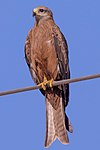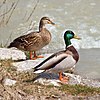List of birds by flight heights
Appearance
This is a list of birds by flight height.
Birds by flight height
[edit]| Bird | Image | Species | Family | Maximum height | Details |
|---|---|---|---|---|---|
| Rüppell's vulture | 
|
Gyps rueppellii | Accipitridae | 11,300 metres (37,100 feet).[1][2] | Vultures use their excellent eyesight to scan the landscape below from a relatively static aerial position. Instead of flying over a larger distance, they use elevation to expand their field of vision.[3] A bird strike was recorded at this height in 1973. |
| Common crane | 
|
Grus grus | Gruidae | 10,000 metres (33,000 feet) | This height was recorded above the Himalayas.[2] This great height allows them to avoid eagles in mountain passes.[2] |
| Bar-headed goose | 
|
Anser indicus | Anatidae | 8,800 metres (29,000 feet)[2][4][5] | They also fly over the peaks of the Himalayas on their migratory path.[4] |
| Whooper swan | 
|
Cygnus cygnus | Anatidae | 8,200 metres (27,000 feet) | This height was attained by a flock of whooper swans flying over Northern Ireland, and recorded by radar.[2][5] |
| Alpine chough | 
|
Pyrrhocorax graculus | Corvidae | 8,000 metres (26,500 feet) | This height was recorded on Mount Everest.[5] |
| Bearded vulture | 
|
Gypaetus barbatus | Accipitridae | 7,300 metres (24,000 feet).[1] | |
| Black Kite | 
|
Milvus migrans | Accipitridae | 6,500 (21,300 feet)[6] | The black kite can reach an altitude of around 37,000 feet especially during their migratory flight to and from West Africa in the second week of September and the last week of May annually.[citation needed] |
| Andean condor | 
|
Vultur gryphus | Cathartidae | 6,500 metres (21,300 feet)[7] | |
| Mallard | 
|
Anas platyrhynchos | Anatidae | 6,400 metres (21,000 feet) | This height was recorded over Nevada;[1][4][5] This record occurred when a Lockheed L-188 Electra turboprop airliner operating a Western Airlines flight suffered a bird strike at cruising altitude.[8] |
| Bar-tailed godwit | 
|
Limosa lapponica | Scolopacidae | 6,000 metres (20,000 feet)[5][9] | It can reach this height while migrating. |
| White stork | Ciconia ciconia | Ciconiidae | 4,800 metres (16,000 feet).[9] | It can reach this height while migrating. |
See also
[edit]References
[edit]- ^ a b c Laybourne, Roxie C. (December 1974). "Collision between a Vulture and an Aircraft at an Altitude of 37,000 Feet". The Wilson Bulletin. 86 (4). Wilson Ornithological Society: 461–462. ISSN 0043-5643. JSTOR 4160546. OCLC 46381512.
- ^ a b c d e Carwardine, Mark (2008). Animal Records. Sterling. p. 124. ISBN 978-1402756238.
- ^ "The Ruppells Griffon Vulture; The Highest Recorded Flying Bird". Boston University.
- ^ a b c Lincoln, Frederick C. (1999). Migration of Birds. U.S. Fish and Wildlife Service. p. 30. ISBN 0160617014.
- ^ a b c d e Whiteman, Lily (2000). "The High Life". Audubon. 102 (6): 104–108. Archived from the original on 9 February 2014. Retrieved 25 February 2014.
- ^ Literák, Ivan; Škrábal, Jan; Karyakin, Igor V.; Andreyenkova, Natalya G.; Vazhov, Sergey V. (2 April 2022). "Black Kites on a flyway between Western Siberia and the Indian Subcontinent". Scientific Reports. 12 (1): 5581. Bibcode:2022NatSR..12.5581L. doi:10.1038/s41598-022-09246-1. PMC 8976839. PMID 35368027.
- ^ Gargiulo, Carolina Natalia (2012). Distribución y situación actual del cóndor andino (Vultur gryphus) en las sierras centrales de Argentina (PDF) (Thesis). Facultad de Ciencias Exactas y Naturales, Universidad de Buenos Aires. Retrieved 2016-04-12.
- ^ "Altitude record for Mallard, The Wilson Bulletin" (PDF).
- ^ a b Elphick, Jonathan (2007). The Atlas of Bird Migration: Tracing the Great Journeys of the World's Birds. Struik. p. 23. ISBN 978-1770074996.
